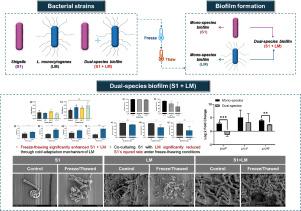福氏志贺氏菌NCCP 10852与单核增生李斯特菌共培养的冻融恢复力:对低温环境下生物膜介导存活的影响
IF 5.2
1区 农林科学
Q1 FOOD SCIENCE & TECHNOLOGY
International journal of food microbiology
Pub Date : 2025-08-20
DOI:10.1016/j.ijfoodmicro.2025.111402
引用次数: 0
摘要
福氏志贺氏菌是一种肠道病原体,传统上与冷冻条件下的生存能力差有关。然而,最近的研究表明,它甚至在冷冻食品中也存在,这引起了人们对其环境适应性的担忧。在现实世界的食品加工环境中,多种微生物经常共存,但福氏梭菌在双种生物膜中的生存动力学,特别是与耐冷单核增生李斯特菌的生存动力学,在很大程度上仍未被探索。本研究旨在探讨在与食物相关的条件下,与单核增生乳杆菌共培养对flexneri冻融(FT)弹性和生物膜形成的影响。实验包括损伤率分析、膜通透性测定、细胞外聚合物(EPS)定量、场发射扫描电镜(FE-SEM)成像、逆转录定量聚合链反应(RT-qPCR)等。结果表明,双种生物膜显著降低了FT条件下flexneri的损伤率,并促进了4°C条件下的生物膜形成。在共培养中,观察到膜损伤增加,EPS产生增加,应激相关基因上调,提示协同生存机制。这些发现表明,当与单核增生乳杆菌共存时,flexneri可以在FT下存活并形成生物膜,可能是通过生物膜介导的保护和种间相互作用。这些发现强调了了解冷冻食品环境中多物种生物膜的重要性。本文章由计算机程序翻译,如有差异,请以英文原文为准。

Freeze-thaw resilience of Shigella flexneri NCCP 10852 in co-culture with Listeria monocytogenes: Implications for biofilm-mediated survival in cold environment
Shigella flexneri is an enteric pathogen traditionally associated with poor survival under freezing conditions. However, recent studies have reported its persistence even in frozen foods, raising concerns about its environmental resilience. In real-world food processing environments, multiple microbial species frequently coexist, yet the survival dynamics of S. flexneri in dual-species biofilms, particularly with psychrotolerant Listeria monocytogenes, remain largely unexplored. This study aimed to investigate how co-cultivation with L. monocytogenes influences the freeze-thaw (FT) resilience and biofilm formation of S. flexneri under food-relevant conditions. A series of experiments were conducted, including injured rate analysis, membrane permeability assays, extracellular polymeric substances(EPS) quantification, field emission-scanning electron microscopy(FE-SEM) imaging, and reverse transcription-quantitative polymeric chain reaction(RT-qPCR). Results showed that dual-species biofilms significantly reduced S. flexneri injured rate under FT conditions and enhanced its biofilm formation at 4 °C. Increased membrane damage, higher EPS production, and upregulation of stress-related genes were observed in co-cultures, suggesting a synergistic survival mechanism. These findings demonstrate that S. flexneri can survive under FT and form biofilms when coexisting with L. monocytogenes, likely through biofilm-mediated protection and interspecies interactions. These findings highlight the importance of understanding multi-species biofilms in frozen food environments.
求助全文
通过发布文献求助,成功后即可免费获取论文全文。
去求助
来源期刊
CiteScore
10.40
自引率
5.60%
发文量
322
审稿时长
65 days
期刊介绍:
The International Journal of Food Microbiology publishes papers dealing with all aspects of food microbiology. Articles must present information that is novel, has high impact and interest, and is of high scientific quality. They should provide scientific or technological advancement in the specific field of interest of the journal and enhance its strong international reputation. Preliminary or confirmatory results as well as contributions not strictly related to food microbiology will not be considered for publication.

 求助内容:
求助内容: 应助结果提醒方式:
应助结果提醒方式:


